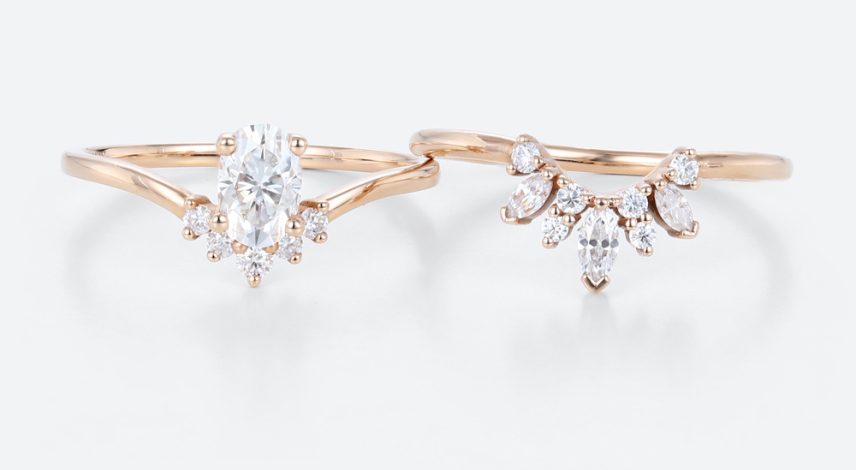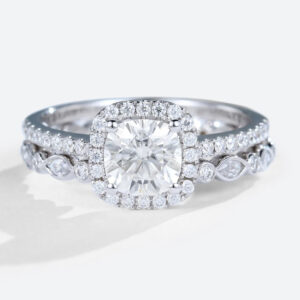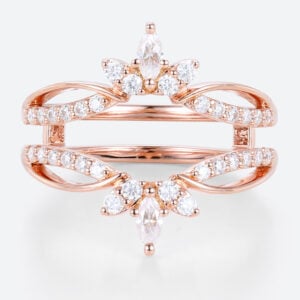How Do You Wear Wedding Band with Engagement Ring?
0 comments
SHOP BY STYLE ✧
SHOP BY SHAPE ✧
![]()
![]()
![]()
![]()
![]()
METAL COLOR ✧
WEDDING BANDS
SHOP BY STYLE ✧
![]()
![]()
![]()
SHOP BY STONE ✧
SHOP BY METAL ✧
JEWELRY FOR THE BIG DAY
NECKLACES ✧
EARRINGS ✧
BRACELETS ✧
Engagement ✧
SHOP BY SHAPE ✧
![]()
![]()
![]()
![]()
![]()
![]()
SHOP BY COLOR ✧
SHOP BY CATEGORY✧

SHOP BY CATEGORY✧
SHOP BY OCCASION✧
SHOP BY PRICE✧

Birthstone Jewelry

When it comes to the symbols of love and commitment, the wedding band and engagement ring are two of the most cherished pieces of jewelry a person can wear. While the engagement ring marks the moment of commitment, the wedding band signifies the bond of marriage. Together, these rings become a powerful representation of a couple’s relationship.
However, many people wonder: How do you wear a wedding band with an engagement ring? Should both rings sit on the same finger? Which ring should go on top? Is there a right or wrong way to stack them? These are common questions that many people ask when they first enter into marriage or begin to wear both rings together.
The tradition of wearing an engagement ring and wedding band on the left hand’s ring finger has been passed down for centuries. Still, modern trends and personal preferences have led to a variety of ways to wear both rings. Whether you want them to complement each other perfectly or stand out as individual pieces, figuring out the right way to wear them can be a fun and personal decision. In this article, we’ll explore the most common ways to wear a wedding band with an engagement ring, along with tips to ensure your rings stay stylish, comfortable, and secure.
The most widely recognized tradition for wearing an engagement ring and wedding band involves placing them on the left hand’s ring finger, which has long been seen as the symbolic finger for commitment and marriage. Here’s a breakdown of the classic approach:
The engagement ring is typically the first ring worn on the ring finger. It is usually presented at the time of the proposal and symbolizes the promise of marriage. According to tradition, the engagement ring is worn on the fourth finger of the left hand, specifically because ancient cultures believed that this finger contained the “vena amoris,” or the vein of love, which was thought to connect directly to the heart. This symbolic connection to love has made it the most meaningful finger for wedding-related rings.
On the wedding day, the couple exchanges rings, and the wedding band is worn on the same finger, placed after the engagement ring. The wedding band represents the union between partners and is meant to symbolize a commitment to the relationship. Traditionally, the wedding band is worn closer to the hand, with the engagement ring sitting on top of it.
In this classic arrangement, the wedding band is considered the more “permanent” ring, as it is the last to be placed during the wedding ceremony. The engagement ring, which typically features a larger diamond or gemstone, often acts as the centerpiece of the two-ring combination. By wearing the wedding band underneath, it can be seen as the “foundation” of the commitment, with the engagement ring sitting above it to highlight the unique promise of marriage.
The order of wearing the rings in this traditional manner is not just about practicality, but also about symbolism. Many people choose to wear their wedding band closest to the heart, feeling that the wedding band is the more intimate and enduring symbol of commitment. The engagement ring, being part of the proposal, often has a more public-facing purpose, announcing the intent to marry, while the wedding band reflects the bond formed during the marriage itself.
In this traditional arrangement, the rings fit together beautifully, with the engagement ring taking a more prominent place while the wedding band sits snugly beneath it. For those who love symmetry, this setup creates a cohesive and elegant look.
While the traditional method of stacking the wedding band below the engagement ring is still widely practiced, there are many other ways to wear both rings, depending on personal style, comfort, and fashion preferences. Here are several popular alternatives:
The wedding band on top and the engagement ring on the bottom is a common alternative for those who want to showcase the wedding band more prominently. Some individuals prefer this arrangement because the wedding band, which is typically simpler or more understated than the engagement ring, is easier to wear daily without feeling too bulky or cumbersome.
This method can also help ensure the engagement ring stays protected, especially if it has a delicate setting or prongs that might get caught on clothing or other objects. Wearing the wedding band on top can provide an extra layer of protection for the engagement ring while keeping both rings comfortably in place.
The traditional arrangement where the engagement ring sits closest to the palm is still the most common method for stacking the two rings. This setup has a couple of key advantages:
One potential downside to this arrangement is that the engagement ring could be slightly more prone to wear and tear since it is more exposed. However, this can be mitigated with careful attention to ring design and metal choice.
Instead of stacking the rings on top of one another, some people prefer to wear their engagement ring and wedding band side by side. This look works well if both rings are equally important in terms of visual impact and design. By wearing the rings side by side, you can showcase both the engagement ring and wedding band without one dominating the other.
This style is great for those who want a more balanced look, especially if both rings feature gemstones or if the wedding band has a unique design that is meant to stand out.
The key to wearing both rings side by side is ensuring they fit properly. The rings should sit snugly next to each other without creating too much space between them. If the rings are too loose, they may move around on the finger, which can be uncomfortable and lead to potential scratching or damage.
While the classic approach is to wear both rings on the same hand, some individuals prefer to wear their wedding band on one hand and engagement ring on the other. This is more common for those who may feel uncomfortable wearing both rings together, or simply want to add a bit of variety to their jewelry collection.
For example, a person might wear the wedding band on their left hand and move the engagement ring to their right hand. This method offers flexibility and gives the individual the opportunity to wear their rings however feels most comfortable. It’s also a good option if the rings feel too bulky or if the person wants to keep one ring less noticeable for professional or personal reasons.

Some couples opt for custom wedding bands and engagement rings that are designed to fit perfectly together as a set. These stacked sets are crafted with both rings in mind, with the wedding band designed to sit seamlessly alongside the engagement ring.
Many designers create rings that “nest” together, ensuring that the engagement ring and wedding band form a perfect pair without any gaps or awkward overlaps. This approach allows couples to combine style and functionality, ensuring both rings fit comfortably and look beautiful when worn together.
Another unconventional way to wear a wedding band is to keep it on a necklace. For some, this can be a practical solution if they want to preserve the look of the engagement ring while keeping their wedding band safe or feeling it’s unnecessary to wear the band all the time. This is also an option for those who are not accustomed to wearing rings on their fingers, but still want to keep the band close to their heart.
Wearing a wedding band on a necklace offers the flexibility to show off the ring when desired, while allowing the person to keep the ring in a safe, secure place.
Ultimately, the way you wear your wedding band and engagement ring is a deeply personal decision. Whether you follow the traditional method of stacking them together, choose to wear them side by side, or opt for a completely unique look, the important thing is that both rings feel right to you. Experiment with different arrangements and enjoy finding the style that best represents your love and commitment.
When it comes to selecting your wedding band and engagement ring, one important decision you’ll need to make is whether to choose matching or mismatched rings. Both options have their own appeal, and it ultimately depends on your personal style, preferences, and how you want your rings to look together.
Matching rings are designed to complement each other perfectly, often created from the same metal, featuring a similar style, and sometimes even incorporating similar stones. The goal with matching rings is to create a cohesive look that feels balanced and unified.
If you have a more elaborate engagement ring with a lot of intricate detailing, you may want a wedding band that doesn’t compete with it visually. A simple, thin band with similar metal and accents can add elegance without overshadowing the engagement ring.
Mismatched rings allow for more personal expression, offering the opportunity to mix different styles, metals, and stones to create a unique combination. For example, a delicate, vintage-style engagement ring can be paired with a modern, minimalistic wedding band, or a colorful gemstone engagement ring could be complemented with a neutral, plain wedding band.
Balance is Key: If you go for mismatched rings, it’s important to ensure that both rings still feel balanced together. While mismatching can be fun, you want to avoid clashing elements that could make the rings feel disjointed. Try to incorporate complementary shapes, stones, or design motifs that tie the two rings together, even if their materials and designs differ.
Ensuring that both your engagement ring and wedding band fit comfortably and securely is crucial to maintaining their beauty and ensuring they stay in good condition. Here are some helpful tips for making sure your rings stay comfortable, fit properly, and are protected during daily activities.
The right size for your engagement ring and wedding band is essential. A ring that’s too tight can be uncomfortable and may cause damage to the ring, while a ring that’s too loose can slip off or rub against other jewelry. The proper fit will ensure that both rings stay securely on your finger and sit comfortably without causing pain or irritation.

Both engagement rings and wedding bands are daily-wear pieces of jewelry, which means they are subjected to frequent friction, scratching, and wear. Preventing damage is key to maintaining the appearance and durability of the rings.
Both rings need to stay securely in place during daily activities. Here are a few tips to ensure that your rings don’t move around too much or risk falling off:
By following these tips for sizing, comfort, and security, you can ensure that both your engagement ring and wedding band remain beautiful and functional throughout the years. The right fit will help you enjoy wearing your rings every day without discomfort, while protecting them from damage.
Wearing your engagement ring and wedding band together is not just a personal choice, but a reflection of your unique love story. Whether you choose to wear both rings in the traditional stack, opt for side-by-side rings, or mix and match styles, the most important thing is that they resonate with your style and your relationship.
Ultimately, both rings serve as symbols of love, commitment, and the journey you’ve shared with your partner. By considering factors like comfort, fit, and the way they complement each other, you can find the best way to wear them in a way that makes you feel confident and happy.